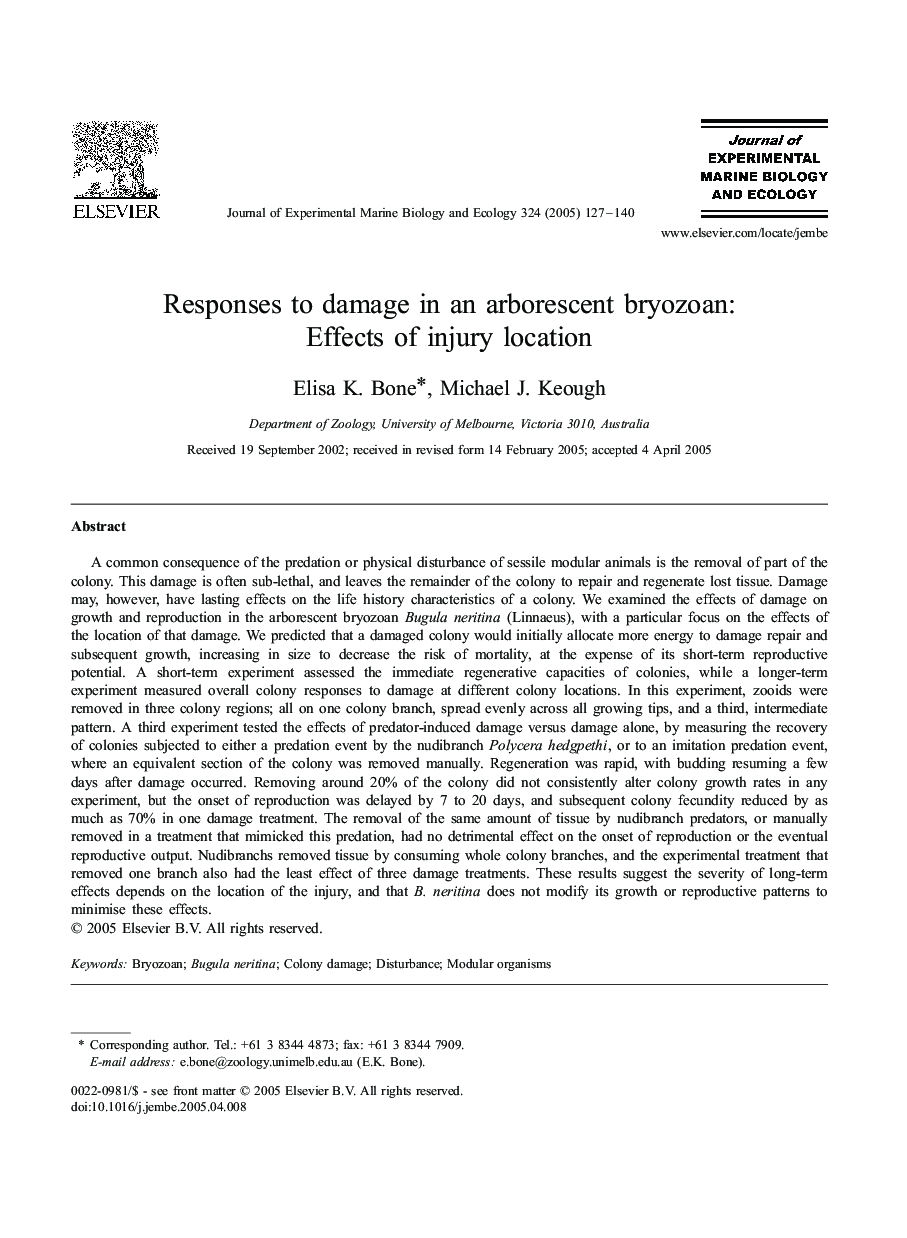| کد مقاله | کد نشریه | سال انتشار | مقاله انگلیسی | نسخه تمام متن |
|---|---|---|---|---|
| 9448725 | 1305948 | 2005 | 14 صفحه PDF | دانلود رایگان |
عنوان انگلیسی مقاله ISI
Responses to damage in an arborescent bryozoan: Effects of injury location
دانلود مقاله + سفارش ترجمه
دانلود مقاله ISI انگلیسی
رایگان برای ایرانیان
موضوعات مرتبط
علوم زیستی و بیوفناوری
علوم کشاورزی و بیولوژیک
علوم آبزیان
پیش نمایش صفحه اول مقاله

چکیده انگلیسی
A common consequence of the predation or physical disturbance of sessile modular animals is the removal of part of the colony. This damage is often sub-lethal, and leaves the remainder of the colony to repair and regenerate lost tissue. Damage may, however, have lasting effects on the life history characteristics of a colony. We examined the effects of damage on growth and reproduction in the arborescent bryozoan Bugula neritina (Linnaeus), with a particular focus on the effects of the location of that damage. We predicted that a damaged colony would initially allocate more energy to damage repair and subsequent growth, increasing in size to decrease the risk of mortality, at the expense of its short-term reproductive potential. A short-term experiment assessed the immediate regenerative capacities of colonies, while a longer-term experiment measured overall colony responses to damage at different colony locations. In this experiment, zooids were removed in three colony regions; all on one colony branch, spread evenly across all growing tips, and a third, intermediate pattern. A third experiment tested the effects of predator-induced damage versus damage alone, by measuring the recovery of colonies subjected to either a predation event by the nudibranch Polycera hedgpethi, or to an imitation predation event, where an equivalent section of the colony was removed manually. Regeneration was rapid, with budding resuming a few days after damage occurred. Removing around 20% of the colony did not consistently alter colony growth rates in any experiment, but the onset of reproduction was delayed by 7 to 20 days, and subsequent colony fecundity reduced by as much as 70% in one damage treatment. The removal of the same amount of tissue by nudibranch predators, or manually removed in a treatment that mimicked this predation, had no detrimental effect on the onset of reproduction or the eventual reproductive output. Nudibranchs removed tissue by consuming whole colony branches, and the experimental treatment that removed one branch also had the least effect of three damage treatments. These results suggest the severity of long-term effects depends on the location of the injury, and that B. neritina does not modify its growth or reproductive patterns to minimise these effects.
ناشر
Database: Elsevier - ScienceDirect (ساینس دایرکت)
Journal: Journal of Experimental Marine Biology and Ecology - Volume 324, Issue 2, 10 November 2005, Pages 127-140
Journal: Journal of Experimental Marine Biology and Ecology - Volume 324, Issue 2, 10 November 2005, Pages 127-140
نویسندگان
Elisa K. Bone, Michael J. Keough,